Cephalothin
- CAS NO.:153-61-7
- Empirical Formula: C16H16N2O6S2
- Molecular Weight: 396.44
- MDL number: MFCD00242614
- EINECS: 205-815-7
- SAFETY DATA SHEET (SDS)
- Update Date: 2025-12-11 08:41:34
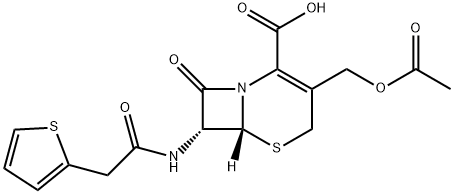
What is Cephalothin?
Toxicity
Rat intravenous LD50 is 4000 mg/kg.
Description
Cephalothin is a semisynthetic, beta-lactam, first-generation cephalosporin antibiotic with bactericidal activity. Cephalothin binds to and inactivates penicillin-binding proteins (PBP) located on the inner membrane of the bacterial cell wall. PBPs participate in the terminal stages of assembling the bacterial cell wall, and in reshaping the cell wall during cell division. Inactivation of PBPs interferes with the cross-linkage of peptidoglycan chains necessary for bacterial cell wall strength and rigidity. This results in the weakening of the bacterial cell wall and causes cell lysis.
Chemical properties
White Solid
Originator
Keflin,Lilly,US,1964
The Uses of Cephalothin
A first generation cephalosporin antibiotic with a wide range antibacterial activity. It is effective against gram-positive and gram-negative bacteria, and has been tested in respiratory disease and neuromuscular junction studies.
Cephalothin is most effective against Gram-positive cocci and is also effective against several Gram-negative organisms. First generation cephalosporins are used primarily to treat skin and soft tissue infections caused by Staphylococcus and Streptococcus species. Cephalothin is ineffective against enterococci and evidence of in vitro sensitivity should be discounted.
Background
Cefalotin is a cephalosporin antibiotic.
Indications
Used to prevent infection during surgery and to treat many kinds of infections of the blood, bone or joints, respiratory tract, skin, and urinary tract.
Definition
ChEBI: Cefalotin is a semisynthetic, first-generation cephalosporin antibiotic with acetoxymethyl and (2-thienylacetyl)nitrilo moieties at positions 3 and 7, respectively, of the core structure. Administered parenterally during surgery and to treat a wide spectrum of blood infections. It has a role as an antimicrobial agent and an antibacterial drug. It is a semisynthetic derivative, a beta-lactam antibiotic allergen, a cephalosporin, a carboxylic acid, a member of thiophenes and an azabicycloalkene. It is a conjugate acid of a cefalotin(1-).
Manufacturing Process
7-(2'-Thienylacetamido)cephalosporanic acid sodium salt may be produced from 2-thienylacetyl chloride, obtainable by treatment of 2-thienylacetic acid [Ernst, Berichte, 19 (1886) 3281] with thionyl chloride in a conventional manner. The 2-thienylacetyl chloride is then reacted with 7- aminocephalosporanic acid and then converted to the sodium salt using sodium hydroxide.
brand name
Keflin (Lilly); Seffin (GlaxoSmithKline).
Therapeutic Function
Antibacterial
Acquired resistance
Cephalothin is relatively susceptible to β-lactamases. Enterobacter, Klebsiella and Citrobacter species have acquired resistance by chromosomal constitutively produced βlactamases that are not inhibited by clavulanic acid. Bacteroides species develop resistance to β-lactams both by plasmids and chromasomally; however Bacteroides resistance remains susceptible to clavulanic acid. P aeruginosa is resistant to first and second generation cephalosporins because of problems with cell permeability/uptake, porin channels and drug efflux. Stenotrophomonas maltophila and Aeromonas species can be resistant through effects on porin channels and drug efflux, while S aureus can also be resistant due to drug efflux.
Mechanism of action
Inhibits bacterial cell wall synthesis by binding to one or more of the penicillin-binding proteins (PBPs) which in turn inhibits the final transpeptidation step of peptidoglycan synthesis in bacterial cell walls, thus inhibiting cell wall biosynthesis. Bacteria eventually lyse due to ongoing activity of cell wall autolytic enzymes (autolysins and murein hydrolases) while cell wall assembly is arrested.
Pharmacokinetics
Cefalotin (INN) or cephalothin (USAN) is a semisynthetic first generation cephalosporin having a broad spectrum of antibiotic activity that is administered parenterally.
Clinical Use
Cephalothin is a relatively short acting first generation cephalosporin that is administered injectably. Although cephalothin is not approved for use in any animal species in the United States, the drug is used clinically in veterinary medicine. Cephalothin can cause nephrotoxicity.
Side Effects
Manifestations may include urticarial or maculopapular rash, bronchospasm, and drug fever. Anaphylaxis, including severe hypotension and cardiac arrest, is reported. Rare cases of renal insufficiency associated with cephalothin may be hypersensitivity-mediated since fever, eosinophilia, and rash are often also present.
https://www.drugs.com
Metabolism
Metabolized to a less active desacetyl metabolite, although 50-75% of the drug is eliminated unchanged in the urine.
Properties of Cephalothin
| Melting point: | 160-161 ºC |
| Boiling point: | 757.2±60.0 °C(Predicted) |
| alpha | D20 +50° (c = 1.03 in acetonitrile) |
| Density | 1.4162 (rough estimate) |
| refractive index | 1.6510 (estimate) |
| storage temp. | Keep in dark place,Sealed in dry,Room Temperature |
| solubility | DMSO (Sparingly), Dioxane (Slightly), Methanol (Slightly) |
| form | Solid |
| pka | pKa 2.5 (Uncertain) |
| color | White to Off-White |
| Water Solubility | 158 MG/L |
| λmax | 263nm(H2O)(lit.) |
| Merck | 14,1982 |
| CAS DataBase Reference | 153-61-7(CAS DataBase Reference) |
| EPA Substance Registry System | Cephalothin (153-61-7) |
Safety information for Cephalothin
| Signal word | Warning |
| Pictogram(s) |
 Health Hazard GHS08 |
| GHS Hazard Statements |
H317:Sensitisation, Skin H334:Sensitisation, respiratory |
| Precautionary Statement Codes |
P261:Avoid breathing dust/fume/gas/mist/vapours/spray. P272:Contaminated work clothing should not be allowed out of the workplace. P285:In case of inadequate ventilation wear respiratory protection. P363:Wash contaminated clothing before reuse. P302+P352:IF ON SKIN: wash with plenty of soap and water. P304+P341:IF INHALED: If breathing is difficult, remove victim to fresh air and keep at rest in a position comfortable for breathing. P333+P313:IF SKIN irritation or rash occurs: Get medical advice/attention. P342+P311:IF experiencing respiratory symptoms: call a POISON CENTER or doctor/physician. P403:Store in a well-ventilated place. |
Computed Descriptors for Cephalothin
New Products
Indole Methyl Resin tert-butyl 9-methoxy-3-azaspiro[5.5]undecane-3-carboxylate Boc-His(Boc)-OH 2-CTC Resin 4-Chloro-7-tosy1-7Hpyrrolo[2,3-d]pyrimidine 5,7-Dibromo-1H-indole 2,5-dichloro-N-hydroxy-4,6-dimethylpyridine-3-carboximidamide 2,2-Dimethoxy-7-azaspiro[3.5]nonane hydrochloride 4-chloromethyl-5-methyl-1,3-dioxol-2-one (DMDO-Cl) R-2-BENZYLOXY PROPIONIC ACID 1,1’-CARBONYLDIIMIDAZOLE 1,1’-CARBONYLDI (1,2-4 TRIAZOLE) N-METHYL INDAZOLE-3-CARBOXYLIC ACID 4-((2-hydroxyethyl)thio)benzoic acid 1-(TERT-BUTOXYCARBONYL)-2-PYRROLIDINONE Methyl 6-methylnicotinate 3-Pyridineacrylic acid tert-Butyl carbazate TETRAHYDRO-2H-PYRAN-3-OL 2-((4-morpholinophenylamino) (methylthio) methylene) malononitrile 3-(4-morpholinophenylamino)-5-amino-1H-pyrazole-4-carbonitrile 2,4-dihydroxybenzaldehyde 1,3-Diethyl-1,3-Diphenylurea Methyl 2-methylquinoline-6-carboxylateRelated products of tetrahydrofuran

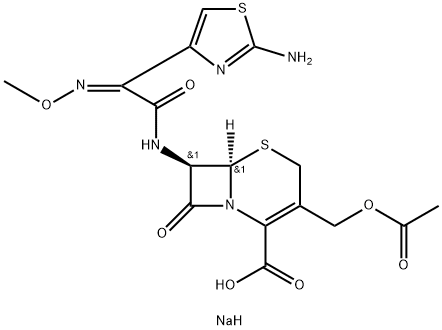
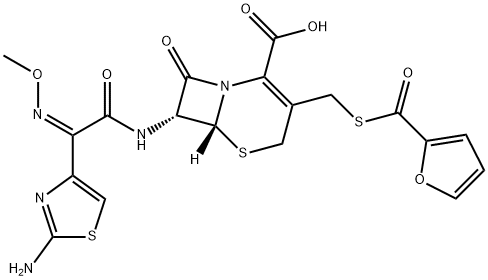
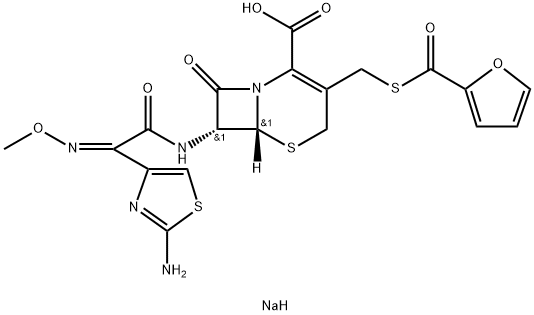
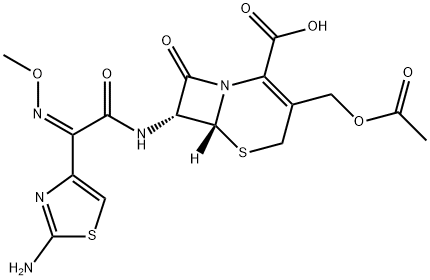
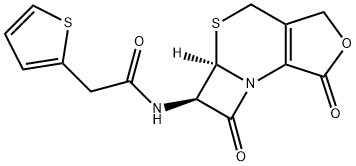


You may like
-
 153-61-7 Cephalothin 98%View Details
153-61-7 Cephalothin 98%View Details
153-61-7 -
 Cephalothin 98% CAS 153-61-7View Details
Cephalothin 98% CAS 153-61-7View Details
153-61-7 -
 Pyridine 99.5% HPLC /UV SpectroscopyView Details
Pyridine 99.5% HPLC /UV SpectroscopyView Details
110-86-1 -
 Piperazine Spot supply, best priceView Details
Piperazine Spot supply, best priceView Details
110-85-0 -
 Dibutyl PhthalateView Details
Dibutyl PhthalateView Details
84-74-2 -
 Imidazole Spot supply, competitive priceView Details
Imidazole Spot supply, competitive priceView Details
288-32-4 -
 Octadecyl 3-(3,5-di-tert-butyl-4-hydroxyphenyl)propionate 98% (GC)View Details
Octadecyl 3-(3,5-di-tert-butyl-4-hydroxyphenyl)propionate 98% (GC)View Details
2082-79-3 -
 Thiourea 99% ARView Details
Thiourea 99% ARView Details
62-56-6
